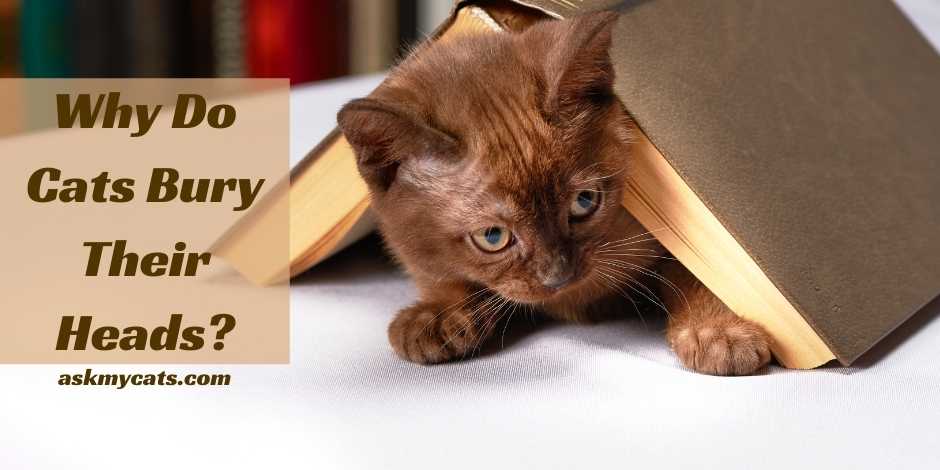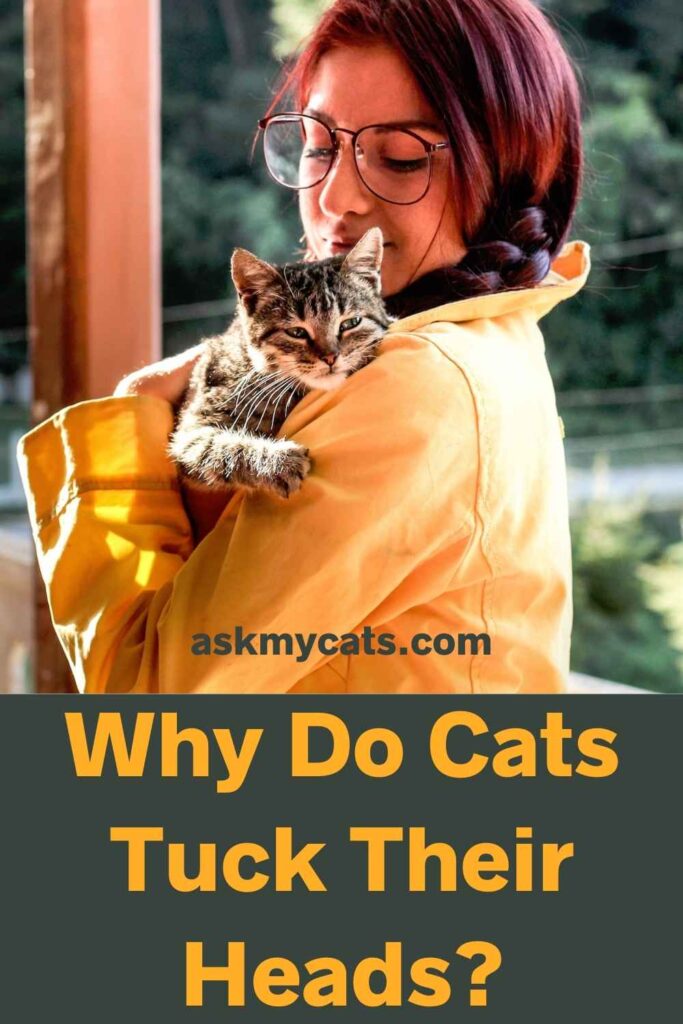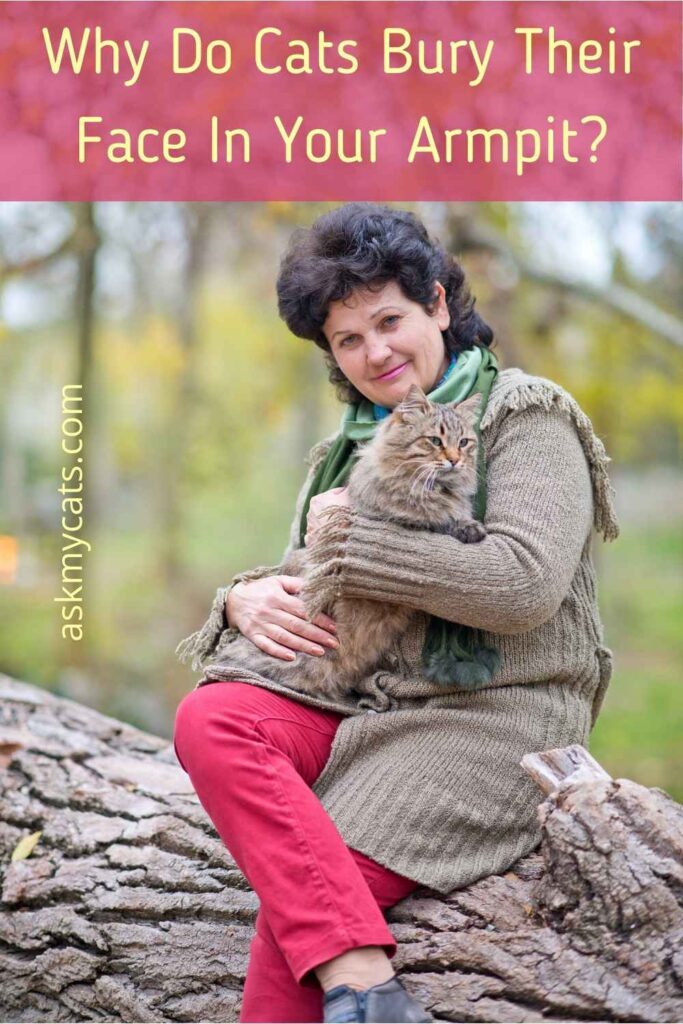If you like cats, you might like one of their most adorable behaviors: head-butting.
Your cat is actually gifting you her smell if she buries her head in your breast, leg, or face. Take the gesture as huge praise from your fuzzy pal.
Cats bury their heads to sleep for warmth, to block off light, or to be more comfortable.
Burrowing cats exhibit love or may even leave a scent trace. This allows cats to check in on their owners and see where they’ve been and how they’re doing.
If a cat buries its head in your palm, it may detect a pleasant scent or link your hand with petting.


Give Your Cat the Perfect Day
Get the Free Ebook!
Why Do Cats Tuck Their Heads?
When cats are feeling comfortable, loving, or in need of calming, they tuck their heads.
As a welcome, cats frequently brush against each other. It enables people to express affection, keep tabs on each other’s health, and update their own smell markers.
It’s possible that cats that bury their heads in your armpit are nervous or in need of reassurance.
Your cat will associate the dark, confined, and warm environment with its litter box or being cuddled by its mother.
Cats are said to be reserved and protective of their own space. That’s why it’s strange when your cat lays its face against you freely.
It may attempt to hide beneath your armpit, head-butt your hand, or crawl against your chest. It will hide its head behind a blanket or its own paws at other times.
It appears cute when a cat hides its head. Then it appears strange. New owners may be concerned that their cat is afraid, light-sensitive, or uncomfortable.
The good news is that a cat ready to bury its head while sleeping feels quite comfortable and secure in its surroundings.
Cats are cautious sleepers because they are predators and prey in the wild. A worried cat may typically sleep in a secluded location.
It will then ensure that its head is exposed, allowing it to quickly awaken. This also enables the cat to hear or detect danger approaching.
Your cat is completely safe if it is willing to close its eyes, nose, and ears to sleep. It is willing to put comfort, filtering off distracting light, and keeping warm ahead of being watchful.
As a result, home cats frequently bury their heads while they sleep.
Your cat’s face may be tucked in:
- It’s on your lap
- A comforter
- A sofa’s back corner
- It has paws of its own.

1. Comfort & Warmth
When it comes to sleeping, cats have a favored stance. Tucking their heads into their paws might help some people sleep better by cushioning their faces.
The coat of a cat protects it from cold and fluctuating temperatures. Curling up and tucking the head away, on the other hand, allows your cat to retain even more warmth.
The cat’s paws act as insulation for places like the nose, around the eyes, and along the jowls (which don’t have as much hair).
2. Security
When a cat is nervous or feels vulnerable, it will want to keep its head exposed so that it can notice and respond to danger.
However, if it senses that a safe haven has been discovered, it will coil up and try to seem smaller. This reduces the likelihood of a hunting predator spotting a feline.
As a result, cats find curling up into a tight ball and hiding their faces soothing. They can still detect arriving predators by leaving their ears exposed, but they will be better hidden.
When the cat feels secure in your household, it may even cover its ears with its paws. Now that it realizes there are no threats, warmth, and comfort are more vital.
3. Keep The Sun Out
Cats enjoy lounging and sleeping in brightly lit areas. A warm, bright environment, on the other hand, might be irritating to the eyes.
If a cat’s face is illuminated directly, it will be unable to slumber correctly and may even experience pain.
A cat will strive to conceal its eyes when sleeping in order to obtain all of the warm effects of sunshine. Tucking its head inside its body is the simplest method to do this.
A cat, on the other hand, will block the sun with its paws or tail.
4. Fell Asleep Bathing
Cats are prone to falling asleep in unusual poses. It can sometimes be utterly unintentional. If your cat doesn’t normally sleep with its head tucked, it most likely did so when washing.
It is not due to laziness that your cat fell asleep during washing. Cats are happy creatures, and keeping themselves clean is very important to them.
Grooming, on the other hand, can take a long time, and cats may become fatigued in the process.
During a grooming procedure, the cat will bury its head and fall asleep to save energy. Once the snooze is completed, it will resume the crucial duty.
You might also like to read why cats sleep with their head upside down
Why Do Cats Bury Their Heads Into You?
A cat buries their head in you because they want to feel the warmth of your body and be comfortable.
Cats don’t only hide their heads when they’re sleeping. When a fully awake cat marches up, stands on your lap, and buries its head in your lap, it is maybe the loveliest and most trusting sight.
The cat could sit there for a while before moving on to anything else. It might even brush its face against you, adjust itself, and bury its head once again.
While this is a heartfelt gesture, it also has a function. It’s possible that the cat is attempting to:

1. Deposit Scent
The smell is vital in the world of cats, and pheromones reign supreme. Sebaceous glands (or scent glands) are found on the chins, ears, and lips of cats.
These contain distinct compounds that other cats can sense via their noses and vomeronasal glands (located on the roof of their mouths).
The best technique to release pheromones in the sebaceous glands, according to the Canadian Journal of Zoology, is to stimulate them.
In other words, cats leave behind their own distinct smell identifiers by rubbing these regions on “their stuff.”
This makes it feasible for the cat to find that thing later, should it be misplaced. It also warns those cats around that the object (or the region around it) is off-limits.
Of course, toys, food bowls, and scratching posts aren’t the only items that fall into this category. Cats also use scent to identify animals (or people) in their social group.
This is why mother cats frequently nuzzle their kittens and mating pairs rub their noses together.
Your cat is intentionally marking you if it approaches you, buries its face against you, and nuzzles the place.
It doesn’t only think of you as a useful member of the group. It wants the other cats to keep their distance.
These pheromones are invisible to humans since our noses only have 25% of the odor receptors that cats have. There’s no need to be concerned about smelling awful.
If you have many cats in your home, they can all try to scent-mark you. This will not result in conflict if they have been reared or trained to get along.
They’ll take turns leaving their own markings instead. The fragrance of forewarning is reserved for unknown animals.
2. Greeting
Touch is as important to cats as smell, therefore burying their face against a loved one acts as a greeting. Cats can obtain a status update on how you’re doing, where you’ve been, and how you’re feeling by doing so.
After your cats have been separated, you may notice them doing this to each other.
Similarly, wild cat communities frequently welcome one another with a little nuzzling session.
This gesture conveys a lot to a cat. It may, for example, be able to detect another cat’s scent or recognize when you smell poorly. It can also detect if you’re chilly, hot, or clammy.
The cat can tell if you’re pleased, sad, or distressed based on your reaction.
All of this offers the feline a more accurate assessment of your condition than if it only looked at you.
The same is true in reverse; the cat may be attempting to communicate its feelings to you. If you were a cat, you’d be able to identify distinct pheromones, fur textures, and noises very instantaneously.
Your cat may welcome you multiple times if it is very nervous. It wants to make sure you’re present, safe, and healthy, and that you’re not being harassed by competitors.
If the cat purrs while rubbing against you, it’s indicating that it’s content.
3. Show Affection
Burying a cat’s face into another species is a tremendous indication of trust and devotion for the feline. It’s willing to peer into your area with its eyes, nose, and mouth.
It longs to be near you, to feel your warmth, and to get a little face massage on your dime. Cats that are at ease, trusting, and affectionate are more prone to bury their faces in your lap.
Whether it’s in the crook of your neck, elbows, or armpits, this is true. When it comes to invading your personal space, loving cats will take no prisoners.
Cats do the same thing with each other. They will cuddle together and bury their heads in each other’s fur if they have welcomed each other into their group or if they are feeling affectionate.
Why Do Cats Bury Their Head In Your Hand?
Cats would usually bury their heads in the widest, warmest region of your body.
When a cat buries its face in your palm, it seems significant since people use their hands for stroking, stroking, hand-holding, and hard handshakes.
In reality, the cat is likely to have picked this location because:
- It’s the most convenient location, particularly if you’ve reached out to pet the cat.
- The cat associates scratching and caressing with the hand.
- Other fragrance markers on your palm are detected by the cat.
- The cat detects the scent of food or goodies on your palm.
- It might be against your breast or your hip. Because of the following reasons:
- The hottest portion of your body isn’t your hands.
- You won’t be able to entirely block out the light with your fingers.
- The majority of owners’ palms aren’t big enough to completely encircle the cat’s head.
- Hands move excessively.
As a result, it’s not a good sleeping area and isn’t as cozy to cuddle with. It’s typically out of convenience that your cat selects this location.
It might also be a temporary nuzzling location until it is able to get into your lap. It will, however, cuddle up and enjoy a pleasurable sniff if it scents catnip or goodies.
Why Do Cats Bury Their Face In Your Armpit?
Your cat buries their face in your armpit because they prefer to nuzzle on the bottom of your arm.

This isn’t the most frequent location, and while it’s a kind gesture, it may also be unpleasant or unpleasant.
This is especially true if you’ve just returned home from the gym or are attempting to complete a task.
Cats do not nuzzle in random places, as they do with all nuzzling. Felines groom themselves constantly to keep unpleasant smells from accumulating in their fur or on their skin.
Mother cats lick and clean their kittens to keep them clean and sanitary. If your cat considers you to be a member of its family, it would want you to smell good as well.
Despite the fact that human odor differs significantly from cat odor, your cat may be able to detect your foul odor.
When compared to dogs, cats are better at recognizing one scent from another. Hundreds of tales of cats being able to detect particular ailments in their owners back up this theory.
Although there’s a potential the cat detects disease on your armpits, it’s more likely that it dislikes your body odor.
It’s trying to hide your aroma with its own cat aroma by burying its face in your armpit and rubbing around. For the sake of the cat’s sensibility, this will be considerably better.
Frequently Asked Questions
Why does my cat bury his face in a blanket?
His pleasant face pheromones are branding you, conveying a sense of familiarity and ease. Cats brush against items in the same way, especially around the house, to remind them that the thing is secure and familiar.
Why does my cat bury her face in my neck?
If you’re a true cat person, you’ve probably heard of bunting, which occurs when a cat bumps her head into you, whether it’s your arm, face, or anyplace else. Your cat is practically giving you her smell if she buries her face in your neck.
Why do cats hide their faces when they sleep?
To keep their noses and bodies warm, most cats sleep with their faces hidden. A cat curls up into a ball form when it wraps its paws or tails around its face. This spherical form allows the cat to retain the most heat, allowing for a pleasant and tranquil slumber.
Final Words
When a cat rubs or presses its head against you, this is known as head butting or bunting, and it is a sign of connection.
Head rubbing is a cat’s technique of identifying its humans and its surroundings with the same smell and grouping them together.
When cats rub a smell mark containing feline face pheromones, they are interacting with other cats.
In essence, the cats leave a fragrance on items that alert other cats to their presence.
